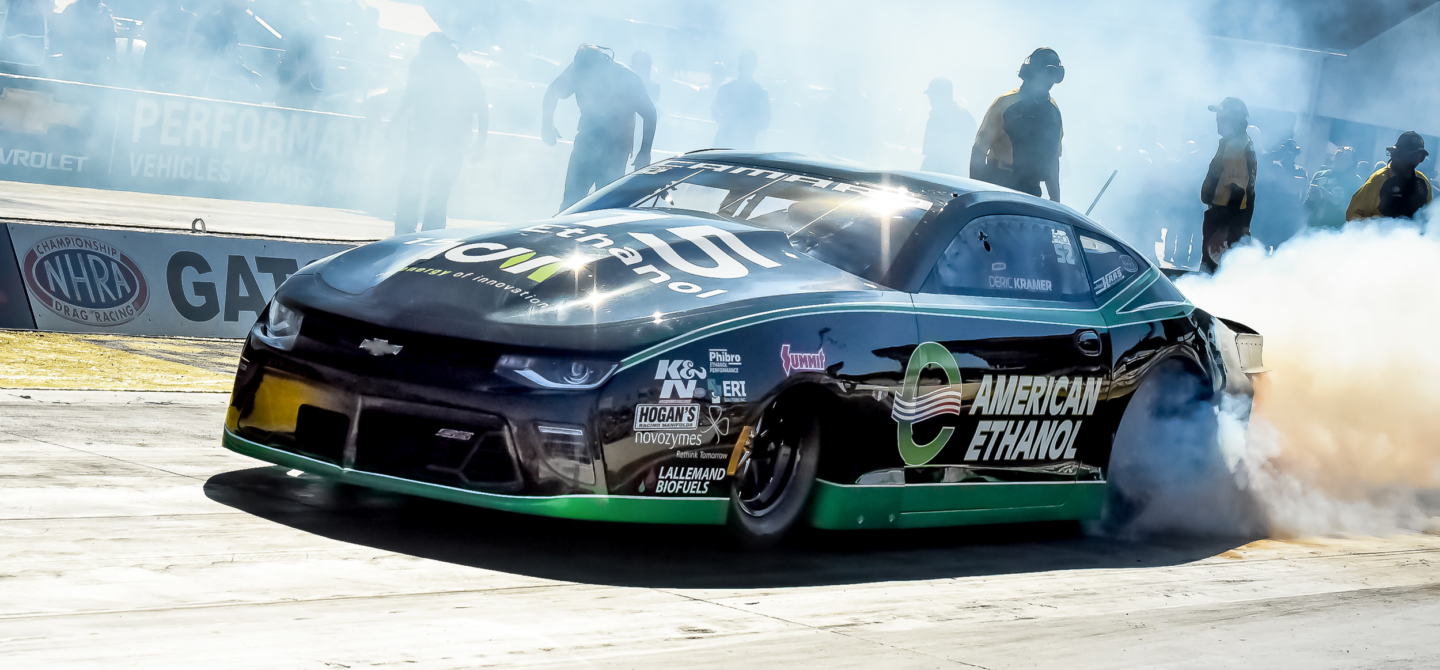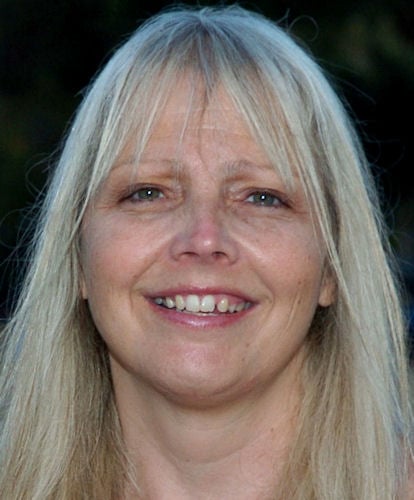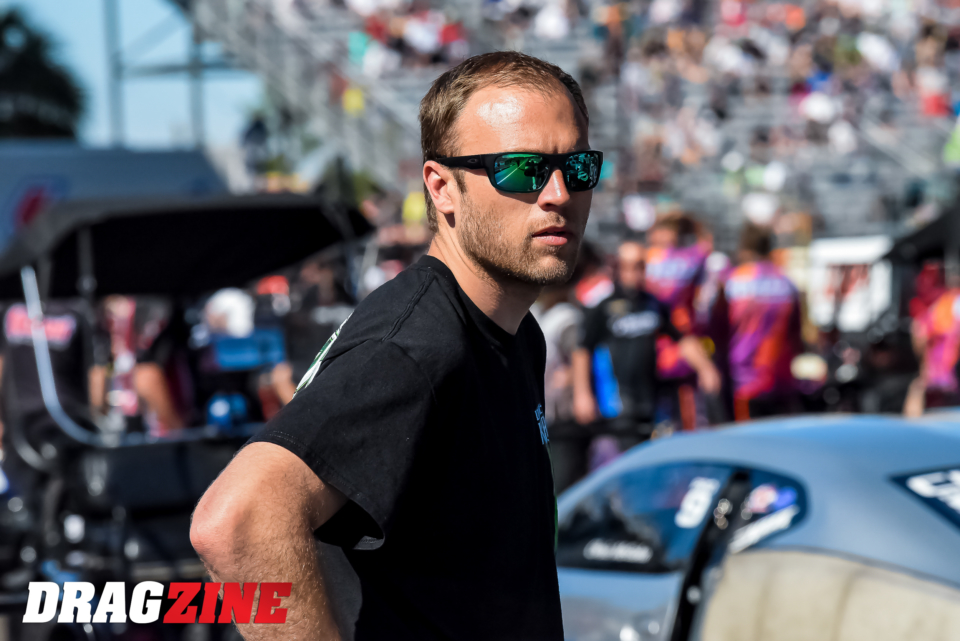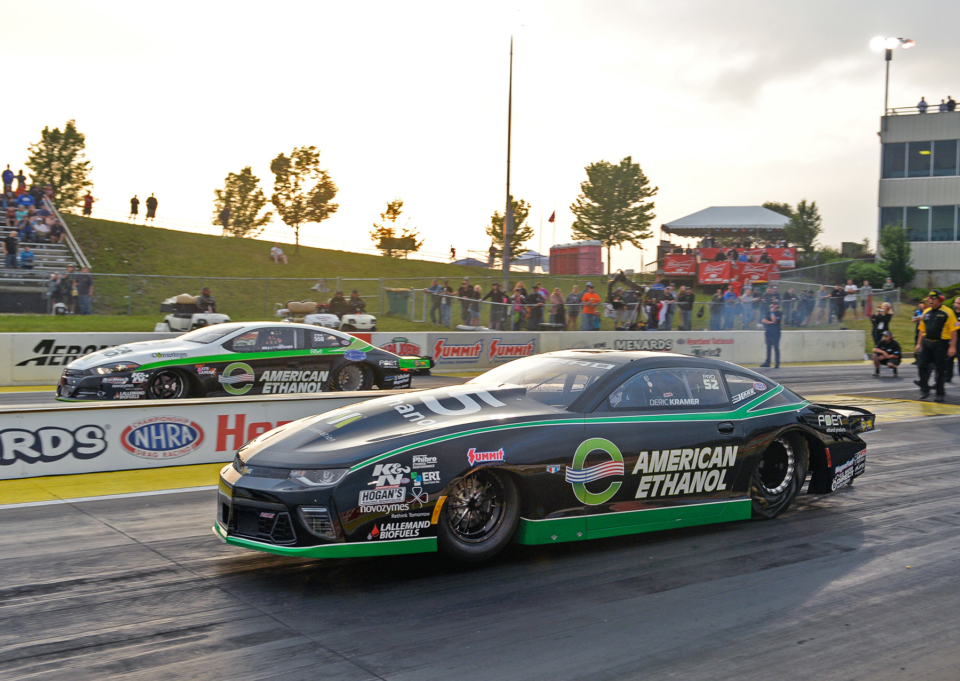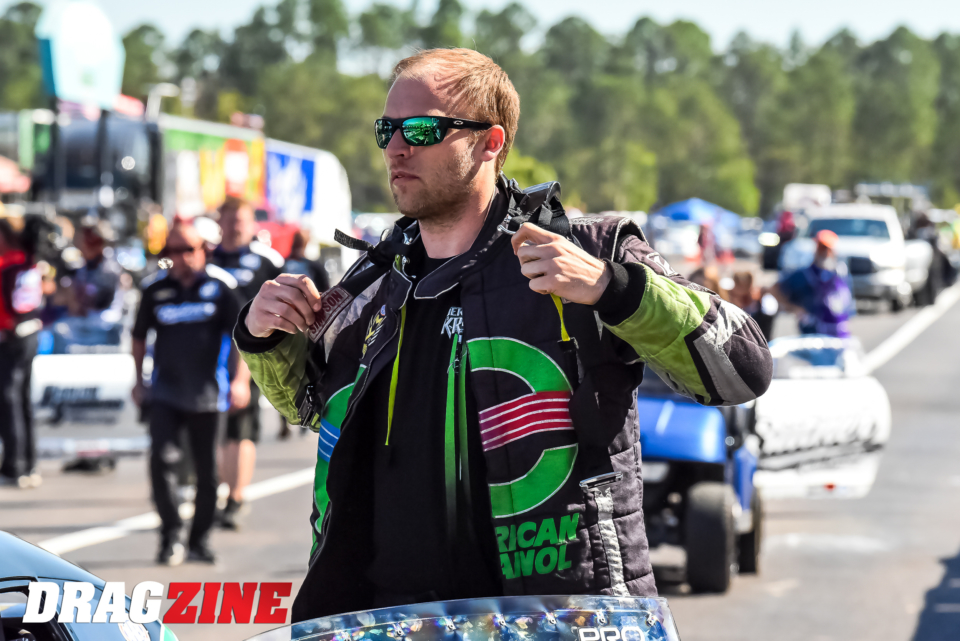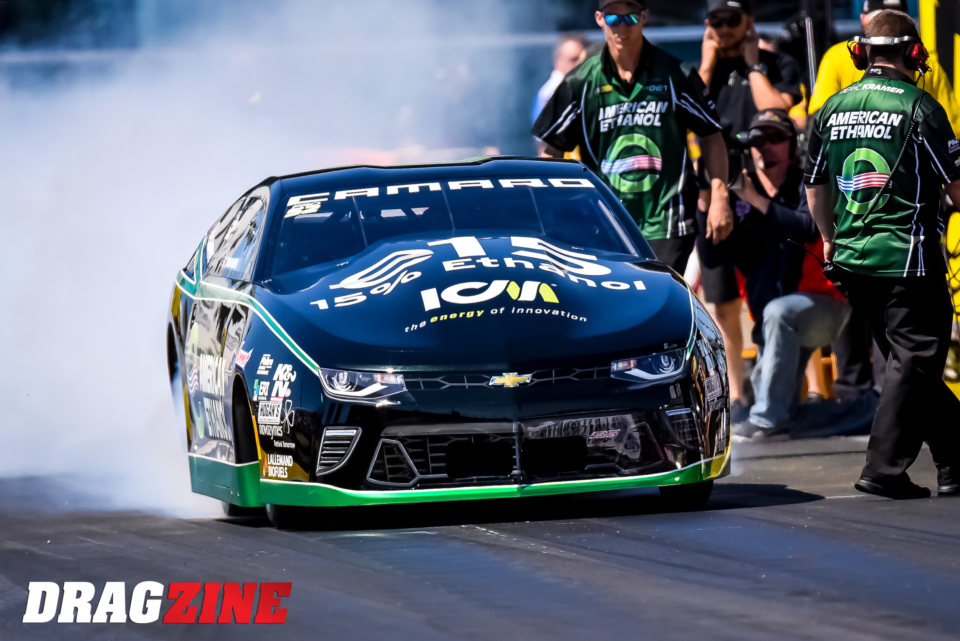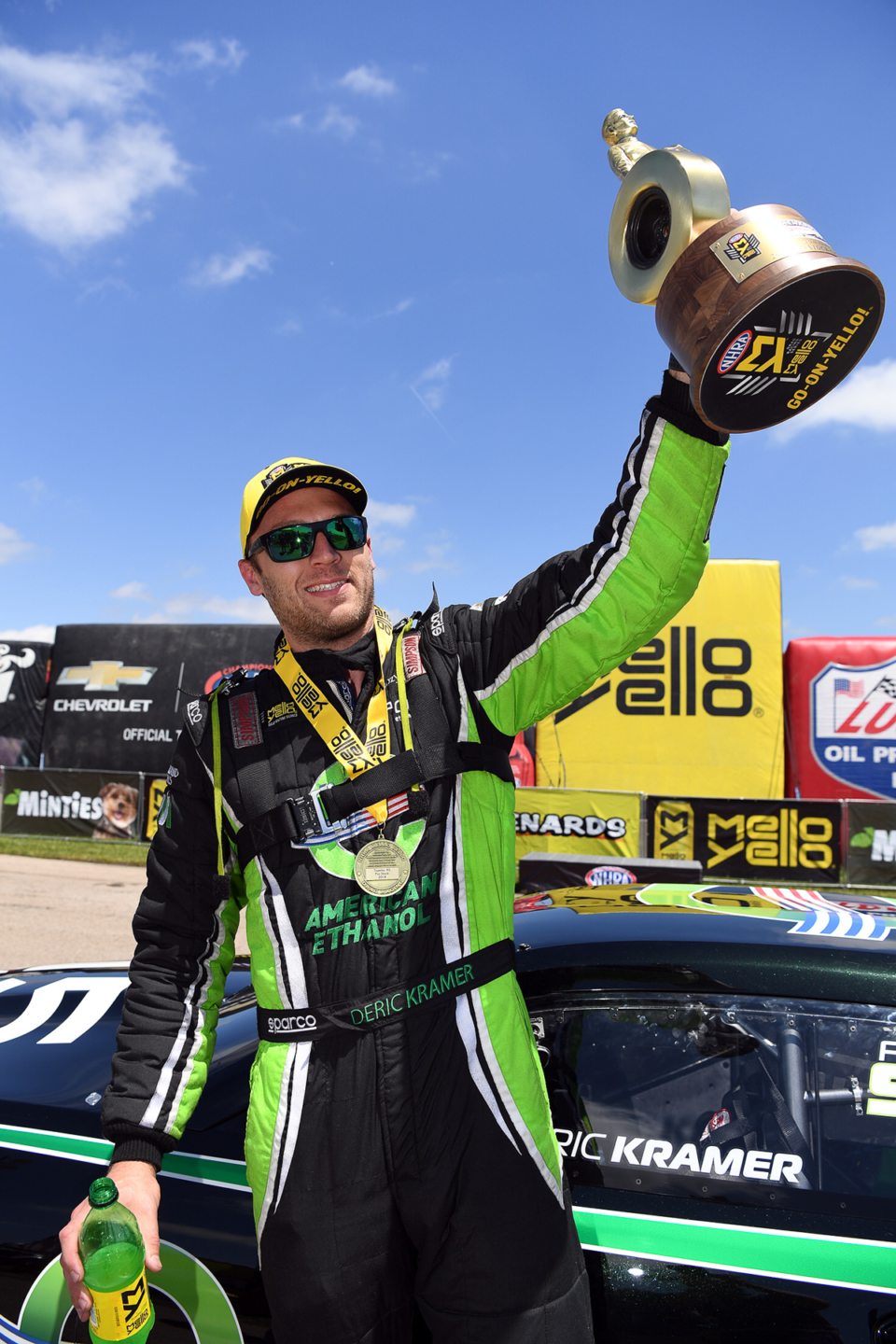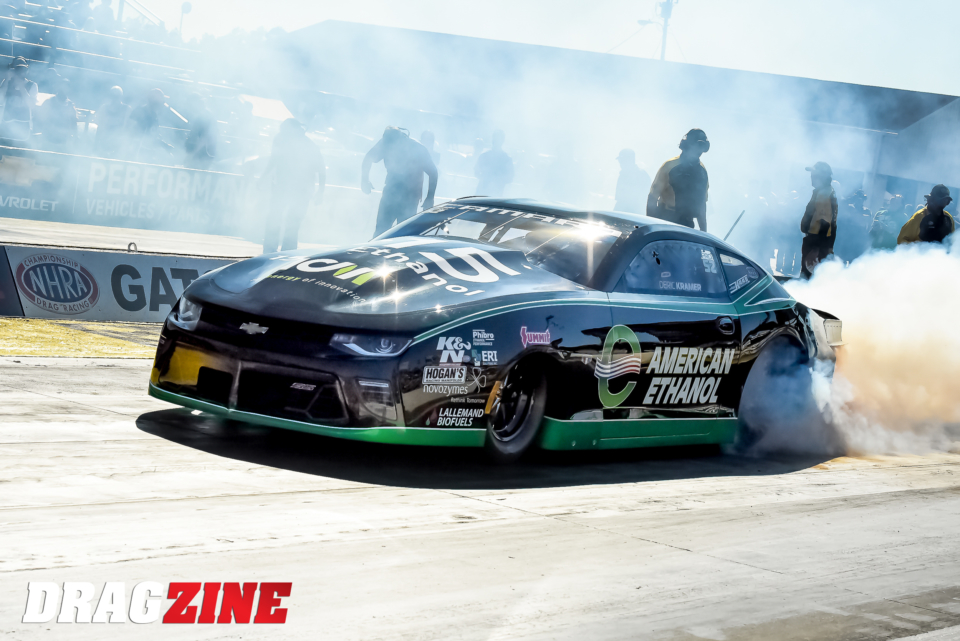If Derek Kramer had a choice between being known as King of the NHRA Pro Stock burnouts or class champion, he naturally would choose the latter.
But curiously, winning the Battle of the Burnouts last Labor Day weekend during the Chevrolet Performance U.S. Nationals at Indianapolis played a role in his shift from struggler to contender, from toiler to spoiler.
Kramer, the tech-savvy mobile-app-writer from Sterling, Colo., was at a crossroads in his pro drag-racing career when the NHRA decided it would ask the Pro Stock class to entertain the crowd during qualifying sessions with big, smoky burnouts (á la the Funny Cars of the 1970s and ‘80s). The NHRA dangled a $5,000 carrot from Denso Spark Plugs to the overall winner and a set of Goodyear tires to the burnout winner of each session.
At the time, the NHRA was threatening to limit the Pro Stock class to 18 races on the 24-event tour and compete in an eight-car field format, at that, because of perceived anemic interest. That was less than two years after the sanctioning body required the Pro Stock class to ditch carburetors and hood scoops (and loosen its grip on proprietary information) – a move that was both costly and performance-reducing.
Kramer, 17th in the standings at that time, said he figured he had nothing to lose.
“I was kind of at the point in the season where I was like, ‘I’m not competitive enough to be out here. Why am I coming out here?’ It was really hard for me to want to get on the plane and go to a race where I was just going to get beat and go home,” he said.
“I was kind of primed to win that,” he said. “At the time we had about 16 Hemi motors that were all about equal in power. With not being anywhere close to the Countdown, and we had determined it knocks about two-hundredths [of a second in elapsed time] off the run, we went out there first session, did an OK burnout and got a decent baseline. The next session was a good session, so we didn’t do a good burnout – actually had to do qualifying. We had a good enough time then that it was going to hold throughout the weekend. So I was able from that point forward just to do big burnouts and get the crowd involved, which was a lot of fun. I had four motors in the trailer that weren’t good enough to win, but they were good enough to qualify. That was just kind of a prime opportunity to say, ‘Let’s give the crowd a show.’ It helped a lot. It definitely brought some fun back for me. It made it more enjoyable to get on the flight.”
I’m not going to lie. It was very much ‘Let’s go out there and we’ll still do the best we can, and I’ll probably get beat. We’ll do a big burnout and let the fans enjoy it.’
Kramer got on his flight home with the $5,000 prize money in his pocket and two sets of brand-new tires in his hauler – and a big leap toward his current status as a title contender.
Today, as the Mello Yello Drag Racing Series heads to Joliet, Ill., for the May 31-June 3 JEGS Route 66 Nationals, Kramer is fourth in the standings, just 34 points off leader Vincent Nobile’s pace. He trails No. 3 Erica Enders by a mere two points and No. 2 Greg Anderson by four. In just eight races this season so far, Kramer has a victory at Topeka, a runner-up finish at Las Vegas, semifinal appearances at Pomona and Phoenix, and No. 1 starts at Phoenix and Topeka, as well as a No. 2 qualifying position at Las Vegas. (He embraced the four-wide format, which expanded to two races this season. “I like the Four-Wide. I think we’re just screwed up enough to do well here,” Kramer said, showing his sense of humor. “All the crazy staging games don’t bother me a bit.”)
Making a splash at Indianapolis “was part of” his rise to the top, Kramer said.
What few knew then was that Kramer had been in negotiations since the July race at Denver with Summit/KB Racing. The plan was for the American Ethanol-sponsored driver to move from his Dodge to a Chevrolet and lease engines from KB.
So the $5,000 wouldn’t be in his pocket for long, but neither would he have the label of “aspiring” much longer.
“We had already started making plans to switch to KB. We had talked to them in Denver and started setting up what the arrangement would potentially be. And by Indy, it was kind of a done deal,” Kramer said. “From that point forward, it was hard to go [to races], because I knew what I was going to be doing next year [2018]. I felt like I had a real shot at what would be this year. And it turns out we were right.”
Even with less-than-competitive equipment, he said he didn’t put pressure on himself during the fall to try to prove to KB that it made the right decision to bring him into the fold with champions Anderson, Jason Line, and Bo Butner.
“I didn’t,” Kramer said. “What I did those last few races was just went up there [to the starting line] and had fun. I did big burnouts in Dallas and Vegas. Basically, that’s what it was for me at that point. It was status-quo, I’m not going to lie. It was very much ‘Let’s go out there and we’ll still do the best we can, and I’ll probably get beat. We’ll do a big burnout and let the fans enjoy it.’ The plan before Vegas and Pomona was just to sit in the water box and smoke the tires until they blew up.”
Now he has a new prize in sight: the $250,000 championship purse.
That wasn’t his goal when he first hooked up with KB Racing, Kramer said: “We were never in the hunt for points. It was never something we talked about doing. It was like, ‘We’re just going to go out there and try to be competitive this year.’”
It’s becoming the closest racing there is. There’s nothing that’s closer than Pro Stock racing right now. No one’s separated by five digits anymore.
His bigger concern, he said, was making sure to have advice from KB during race weekends.
“We wanted to make sure if we were screwed up, they would help.”
Kramer described the association this way: “They supply the engines. I’m the fourth driver under KB power, but I’m not their fourth car. We run our car. Our car is entirely separate. They set up all three of those cars [Anderson’s, Line’s, and Butner’s], but our car is entirely set up by us. They know what we do and have our data. We try to help them, too.”
Crew chief Mike Hiner, who came highly recommended by class veteran V. Gaines, “was always saying we should have been in this Camaro, or in a Chevy, the whole time,” Kramer said. “It was definitely a learning curve for him when we first started, because [the Dodge] didn’t have as much torque as he was used to, and he had to tweak a little bit. But we did a pretty good job of getting where we were with the Dodge. I don’t think we could have done much better with what we had.”
So Hiner – who was Ron Krisher’s crew chief, clutch specialist for George Marnell, and worked in the late 1990s for Mark Pawuk after a stint in NASCAR – is much more comfortable with the new equipment. Together they’re making a run for the title.
Kramer, whose career turned around seemingly overnight, shares the experience with the Pro Stock class. It seems to have weathered the storm of 2017, too. He said his take on the state of the Pro Stock class is it’s healthy.
“The way I see it right now, in 2015, before the rules change, I kind of feel like we’ve made it back to that point,” he said. “In 2015, we were very close, even with our [less-than-competitive] stuff, I was within four- to five-hundredths of the No. 1 qualifying car – which is the closest I’ve ever been with my stuff. I think we’ve just gotten back to that point. It’s becoming the closest racing there is. There’s nothing that’s closer than Pro Stock racing right now. No one’s separated by five digits anymore. To me, that’s the most exciting photo finish you can get, when you look at the photo and think, ‘I don’t know who won.’”
He said he isn’t sure why Pro Stock has been such a hard sell.
I have a Nissan 350Z. I love it. It sits in the race shop, next to my Chevelle. I have no question that if somebody was out there racing a 370Z or a Nissan GT-R body style, then more of those would sell.
“I don’t know, especially now that the hood scoops are gone. The hood scoops are gone and now the [sight] lines are the same as you have on the car in the driveway. I think some of the choices of the other manufacturers– like I don’t think the Dodge Dart was a good choice for a Pro Stock car. No one relates to the Dodge Dart. Now, the Mustang and the Camaros, I think, are great choices,” he said. “I want to say I heard Toyota is really interested in the Pro Stock class but they were against it because of the hood scoops. Now that the hood scoops are gone, it’d be nice to reach out to Toyota and see if [the interest] is something that would come back.”
To date, Toyota has given no indication it has an interest in becoming involved in the Pro Stock class. No other foreign automaker has made overtures to the NHRA, either, although that market might hold the key to the younger demographic the NHRA needs to attract. Conventional wisdom says young adults aren’t part of a car craze like the one that swept the 1950s and gave rise to this sport. Others contend that isn’t true but that today’s youth are less interested in domestic makes than in foreign ones. Kramer indicated that’s his experience.
“The first car I bought myself was a Nissan. I still own it. I have a Nissan 350Z. I love it. It sits in the race shop, next to my Chevelle. I have no question that if somebody was out there racing a 370Z or a Nissan GT-R body style, then more of those would sell. I have no question in my mind that’s exactly what would happen — especially now that you don’t have to get a motor combination approved,” he said. “I could put a Hemi in a Toyota, if I wanted.”
That’s what the NHRA was hoping more lower-budgeted racers would do to take advantage of a more cost-effective option when starting this year it allowed racers to mix and match bodies and engines. The ruling stirred a lot of hoopla, but only one racer has taken advantage of the opportunity.
“Mark Hogan was the first person to do it, last weekend [at Topeka]. He had one of our Hemis from last year in his GXP,” Kramer said.
That means that it took eight races to entice one driver to mix and match.
Kramer said he likes the rule: “It’s an additive thing to the class. It doesn’t take anything away from the class. So we should do it. I think what it did was made the people who are going to be 16th-17th-18th have another avenue to go. If they couldn’t get enough power out of their stuff, they could buy a three- or four- or five-year-old motor from somebody else, put it in a car and go race.”
He said he has heard Elite Motorsports might be thinking of doing it.
“I heard Elite might be putting a Chevy [engine] in one of the Mustangs they’re building. But I don’t know. I heard Elite is building two Mustangs. They know what [horsepower] their Chevy motors can make. So why start a new engine program, when you can put the same motors in a new car?” Kramer said.
Kramer has come a long way from the day in 2011 when he asked fellow Colorado Pro Stock team owner-racer V. Gaines, “Can we do this thing? Can we get your hand-me-down stuff and have fun and learn the ropes?” He has stepped up from those hand-me-down Dodge Avengers and Darts to a more viable Chevrolet.
They supply the engines. I’m the fourth driver under KB power, but I’m not their fourth car. We run our car. Our car is entirely separate.
But Kramer still takes pride in those burnouts: “I think after I started it in Pomona, more people started doing it – like, ‘Hey, this is fun. Let’s go do that.’” Even Pro Stock Motorcycle’s Matt Smith got in on the schtik. But he said such a phenomenon would suit the racers better as an exhibition.
“You take two-hundredths off anybody … When you’re trying to win, you can’t [engage in burnout contests]. That’s the downside. If you’re just going up there to entertain the crowd with one big burnout, then that’s fine. You can show ‘em a great time, and that’s awesome. But you can’t win that way.”
And Deric Kramer is out there to win – not just a Battle of the Burnouts but the Mello Yello series championship.


